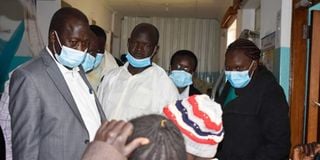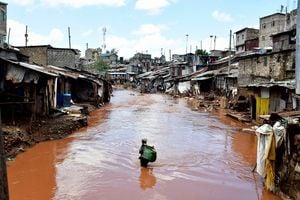Non-functioning hospitals: Baringo residents have to walk long distances to access health services

Baringo Governor Benjamin Cheboi (in grey suit) talking to a patient while on an inspection tour of Eldama Ravine sub-county hospital on August 28,2022. Locals had complained about poor service delivery and lack of drugs at the facility.
What you need to know:
- Completed but idle facilities are Korelach, Sugut, Ng’aina, Chewara, Cheptaran, Mbechot, Sagasagik, Kokwototo, Orus, Loyeya, Kadokoi, Donge, Cheptaran, Nasur, Akoreyan, Seretion, Maregut, Kipkaren, Terik, Longewan, Katikit, Root, Kimugul, Ngeiwan and Kiptaiwa
- In some areas, expectant women seek services from traditional birth attendants, which is risky, especially when birth complications develop
Several health facilities in remote areas of Baringo are not operating years after they were constructed, forcing locals to walk long distances to access health services.
More than 45 dispensaries and health centres were set up by the devolved unit in far-flung areas between 2013 and 2017. Although most of them were completed with millions in taxpayers’ money, they are yet to start offering services.
But Governor Benjamin Cheboi has promised to equip and staff them.
At a meeting with the county assembly’s committee on health and the county health department, Governor Cheboi promised to streamline the health sector, citing a myriad of challenges, among them a shortage of drugs and staff.
“We need the health department to be put in order, including redeploying some staff to the far-flung health facilities that have remained idle due to lack of health workers,” the governor said.
“We are working on fully equipping them to save locals from walking long distances in search of services.”
Work on the Toplen health centre in the remote Silale ward in Tiaty sub-county, for instance, started in 2013 and was completed in 2015 for Sh6.7 million, but it is yet to be equipped with drugs and staff.
Mission hospitals
Locals rely on outreach missions sponsored by World Vision, the Red Cross and religious organisations, which are not always available, especially in emergencies.
Expectant women seek services from traditional birth attendants, which is risky, especially when birth complications develop.
Other completed but idle facilities are Korelach, Sugut, Ng’aina, Chewara, Cheptaran, Mbechot, Sagasagik, Kokwototo, Orus, Loyeya, Kadokoi, Donge, Cheptaran, Nasur, Akoreyan, Seretion, Maregut, Kipkaren, Terik, Longewan, Katikit, Root, Kimugul, Ngeiwan and Kiptaiwa.
Governor Cheboi said six Level Four hospitals – Kabarnet, Mogotio, Eldama Ravine, Marigat, Chemolingot and Kabartonjo – will be managed independently to make them more efficient.
“We also want to ensure that our laboratories in all Level Three hospitals are properly equipped so that patients in remote areas will not incur a lot of costs travelling long distances to seek such services, which can be done in those facilities,” he said, adding that this will help decongest referral hospitals.
Budgetary adjustments
The executive and the assembly’s health committee will hold regular meetings to track budgetary adjustments that may be needed to improve health facilities, he said.
Kenya Medical Practitioners, Pharmacists and Dentists Union (KMPDU) has protested poor health services at hospitals in the region, citing acute staff shortages and poor working conditions.
This, the union argued, had led to increased referrals of patients for specialised treatment to hospitals in neighbouring Nakuru and Uasin Gishu counties.





